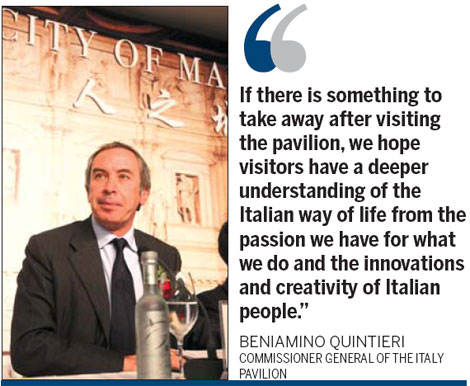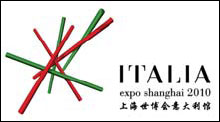Land where tradition meets innovation

As the second largest pavilion after the China Pavilion in the Expo Garden, the Italy Pavilion features interlinking walkways and varied exhibits.
The pattern of narrow and intersecting alleys leading into open spaces is reminiscent of the Shikumen-style of old Shanghai, as well as the narrow alleys of Italy, an interesting parallel between the two cultures.
"The different sections of the building reflect the diversity and complexity of regional cultures, which define the identity of Italy. The idea is akin to a mosaic, where only together can the different parts display the whole picture," said Beniamino Quintieri, commissioner general of the Italy Pavilion.
'City of Man'

Themed the "City of Man", the Italy Pavilion transcends a city designed and built to accommodate the needs and ambitions of man, at the same time as having a deep respect for his environment. It represents a proposal for a better city molded to man's needs, one that is livable and stimulating, beautiful and efficient.
Italy seeks to share the experiences of its own cities, which for thousands of years have faced the problem of balancing protection of historical inheritance with the needs of people and urban life.
The interior is divided into irregular sections of different dimensions connected by aerial bridges. Architects have also deliberately embedded Chinese elements into the design of the Italy Pavilion.
"If there is something to take away after visiting the pavilion, we hope visitors have a deeper understanding of the Italian way of life from the passion we have for what we do, to the innovations and creativity of Italian people," Quintieri said.
The Italy Pavilion is a reflection of history fused with the modernity of Italy today. The entrance gate is a replica of the Olympic Theatre in Vicenza built in 1585, but there is also a street-cleaning robot on display. It is a "Paradise for everybody", with technology, arts, fashion, music and food.
The first floor of the pavilion hosts a glass room named "The Making Of", where the visitor can experience the relationship between art and technology and witness the highly specialized nature of Italian craftsmanship in a "live" workshop.
"The live workshops include shoe-making by Ferragamo, sofa-making by Poltrona Frau, and restoration of cultural relics and making of the popular wooden Pinocchio," Quintieri said.
Italy's wealth derives from the vast multifaceted diversity of her regions, towns and cities, each with their own identity. A total of 12 regions and three cities will take turns to showcase their uniqueness through exhibitions showing technologies and innovations, art shows and cultural performances, food and wine tasting, and business and investment seminars.
China has caught the world's attention through the Shanghai Expo 2010. For Italy, it is a perfect platform to introduce Italy to China and encourage more business, trade and cultural exchanges between the two countries.
"I think the Expo presents an important opportunity to increase knowledge of Italy in China. Italy is well known for its fashion and luxury brands, but many are not aware of our high-tech industries and best practices across various business sectors. We hope to show them the wide range of opportunities in Italy," Quintieri said.
 0
0 







Go to Forum >>0 Comments